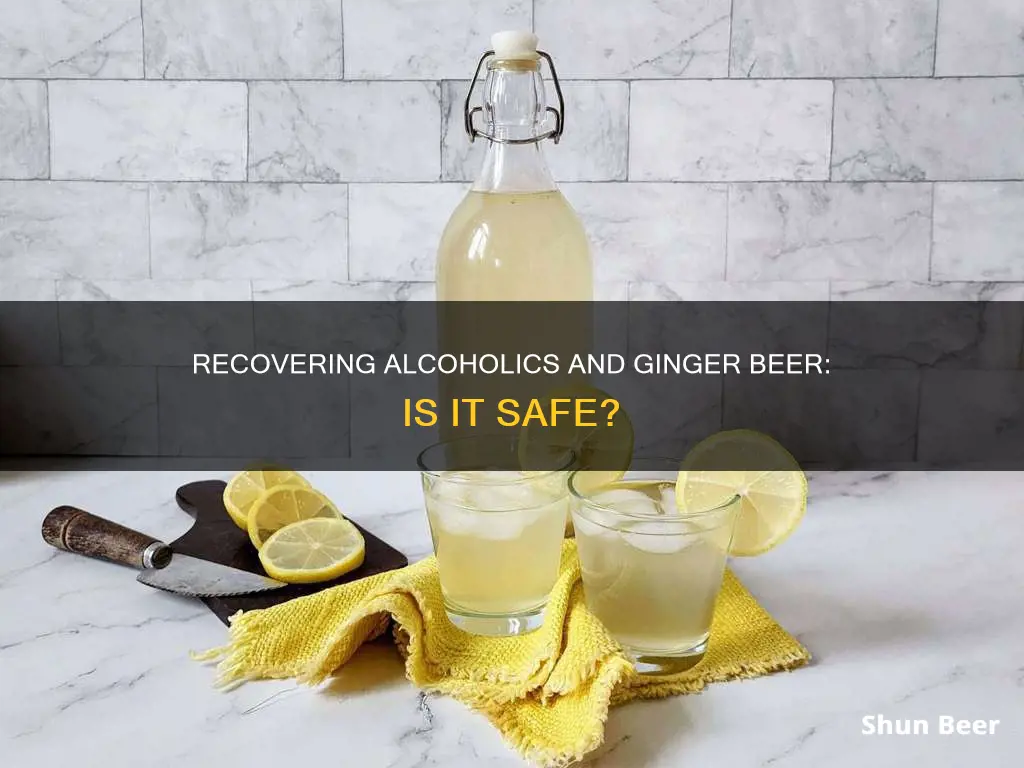
Ginger beer is a sweetened and carbonated beverage that is usually non-alcoholic. However, it can also be brewed and fermented to produce an alcoholic drink. The fermentation process involves the use of a ginger beer plant or a ginger bug starter, which ferments ginger, sugar, and water. This results in an alcoholic beverage with an alcohol content similar to that of beer, typically between 3% and 5%. For recovering alcoholics, it is crucial to be aware of the potential presence of alcohol in ginger beer and make an informed decision about consumption. While non-alcoholic ginger beer can be a refreshing alternative, the alcoholic version should be avoided to maintain sobriety.
| Characteristics | Values |
|---|---|
| Alcohol content | Ginger beer can be alcoholic or non-alcoholic. |
| ABV | Alcoholic ginger beer is typically between 3% and 5% ABV. |
| ABV | Non-alcoholic ginger beer is typically below 0.5% ABV. |
| Ingredients | Ginger, sugar, water, and yeast. |
| Production method | Ginger beer can be brewed or manufactured. |
| Carbonation | Ginger beer is carbonated. |
What You'll Learn

Ginger beer can be alcoholic or non-alcoholic
Ginger beer is a drink that can be either alcoholic or non-alcoholic. The drink is typically made from fermenting ginger, sugar, and water, and sometimes lemon. The alcohol content depends on how it is made and where it is sold.
Alcoholic Ginger Beer
Brewed ginger beer originated in the UK and is sold worldwide. It is usually labelled "alcoholic ginger beer" to distinguish it from non-alcoholic ginger beers. The alcohol content is similar to that of a beer, which is usually between 3 and 5%.
Non-Alcoholic Ginger Beer
Non-alcoholic ginger beer is commonly a carbonated soft drink flavoured with ginger. It is often manufactured with flavour and colour additives, and carbonated with pressurized carbon dioxide. However, some non-alcoholic ginger beers are made by brewing, followed by heating to reduce the alcohol content to below 0.5% ABV, which is the legal limit for "non-alcoholic" classification in many places.
History
Ginger beer originated in Yorkshire, England, in the mid-18th century and became popular throughout Britain, the United States, Ireland, South Africa, the Caribbean, and Canada. Traditional ginger beer was an alcoholic drink, with about 11% alcohol content, made by fermenting and brewing ginger with water and sugar.
Exploring Alcohol Culture: Beer Drinking in Israel
You may want to see also

Recovering alcoholics should opt for non-alcoholic ginger beer
Non-alcoholic ginger beer is a great option for recovering alcoholics as it is a tasty drink that can be enjoyed on its own or as a mixer. It is also a good alternative to plain water or juice, which can get boring. It is a carbonated drink flavoured with ginger, and it often contains sugar or high-fructose corn syrup.
Ginger beer is easy to make at home, and this is a fun way to enjoy the drink. It is brewed using a ginger beer plant, which is a form of fermentation starter, or a ginger bug, which is made from fermenting ginger, sugar, and water. The drink is then bottled and carbonated.
However, it is important to note that non-alcoholic ginger beer may still contain a small amount of alcohol, as some are made by brewing and then heated to reduce the alcohol content to below 0.5% ABV. Therefore, it is important to check the label if you are avoiding alcohol completely.
Overall, non-alcoholic ginger beer is a good option for recovering alcoholics as it is a tasty and fun drink that can be enjoyed on its own or as a mixer, and it is easy to make at home. Just be sure to check the label to ensure it is truly non-alcoholic if you are avoiding alcohol completely.
Melatonin and Beer: Safe Mix or Health Risk?
You may want to see also

Non-alcoholic ginger beer is a carbonated soft drink
Non-alcoholic ginger beer is often manufactured with flavour and colour additives, and carbonated with pressurized carbon dioxide. However, it can also be produced at home, using a "ginger beer plant" or a "ginger bug" starter, which is created from fermenting ginger, sugar, and water. The "ginger beer plant" is a form of fermentation starter, composed of yeast and bacteria, which creates the fermentation process.
The process of making non-alcoholic ginger beer involves combining water, sugar, ground ginger, and brewer's yeast. This mixture is then fed daily with sugar and ground ginger for a week, strained, mixed with cold water and lemon juice, bottled, and left to stand for at least a week until it becomes fizzy.
Non-alcoholic ginger beer can be enjoyed on its own as a refreshing drink or mixed with other beverages to create cocktails such as a shandy or a Dark 'N' Stormy.
Beer and Terbinafine: Safe Mix?
You may want to see also

Ginger beer can be brewed at home
Ingredients:
- 1 cup granulated sugar
- 2 tablespoons grated fresh ginger
- 1/8 teaspoon active dry yeast or brewer's yeast
- 3 tablespoons lemon juice, freshly squeezed
- 7 cups filtered water
Equipment:
- Clean 2-litre soda bottle
- Funnel
Method:
- Peel and grate the fresh ginger using a box grater.
- Place the ginger, sugar, and water in a saucepan over medium heat and stir until the sugar is dissolved.
- Turn off the heat and allow the mixture to steep for an hour.
- Strain the mixture (discard the ginger solids) and allow it to cool.
- You've now made ginger syrup.
- Place a funnel in the top of the bottle. Sprinkle the yeast in, followed by the syrup, lemon juice, and water.
- Put the lid on the bottle and shake the concoction until the yeast is dissolved.
- Stow it on a shady shelf or in your pantry out of direct sunlight for 2-3 days, or until fizz is achieved.
- At this point, it is ready to drink and must be stored in the refrigerator to prevent further fermentation.
Notes:
- This recipe creates a very slight alcohol content, so be aware if you are sensitive to alcohol.
- Be sure to open the bottle every day to release the extra gas, otherwise the bottle might explode.
- The photos in the blog post above were taken using a glass bottle. Please keep in mind that home brew is volatile in nature. If you will not be releasing built-up pressure as it ferments, use a plastic bottle instead.
Beer and Symbicort: Is It Safe to Drink?
You may want to see also

Ginger beer is flavoured with ginger root
The process of making ginger beer starts with the preparation of a "ginger bug" or "ginger beer plant," which serves as a starter culture. This is created by combining ginger, sugar, and water and allowing it to ferment for several days. The "ginger bug" can be further fed and kept for future batches or stored in the fridge to go dormant.
To make the ginger beer, the "ginger bug" is mixed with water, sugar, and sometimes additional ingredients like lemon juice and cream of tartar. This mixture is then left to ferment for several days, converting some of the sugar into alcohol. The fermentation time can be adjusted to control the alcohol content, with longer fermentation resulting in a higher alcohol percentage.
After fermentation, the mixture is strained, diluted with water, and bottled. The bottled ginger beer is then stored in a dark place for at least a month to enhance the flavour and develop carbonation. The drink can also be garnished with lemon slices and mint leaves before serving.
It is important to note that the fermentation process must be carefully monitored, as incomplete fermentation can lead to excessive carbonation and potential bottle explosions. Additionally, the alcohol content should be considered when serving, especially for those who are recovering alcoholics. While non-alcoholic ginger beer is widely available, it is always a good idea to check the labels and ingredients to ensure it aligns with one's recovery journey.
Drinking Beer in Kansas: Understanding the Legal Age Limit
You may want to see also
Frequently asked questions
It depends on the type of ginger beer. Traditional ginger beer is non-alcoholic, but some modern ginger beers are brewed with alcohol.
Check the label. Alcoholic ginger beer is usually labelled as such, and non-alcoholic ginger beer is often referred to as a "soft drink".
Alcoholic ginger beer typically has an alcohol content similar to beer, which is usually between 3% and 5%. However, it's impossible to gauge the exact alcohol content of homemade ginger beer.
Yes, you can brew your own ginger beer at home. The process is simple and only requires a few ingredients, such as ginger, sugar, water, and brewer's yeast.
Ginger has been associated with several health benefits, including reduced nausea, antioxidant effects, improved heart health, and reduced inflammation. However, these benefits are related to the ginger itself, not necessarily to ginger beer.







